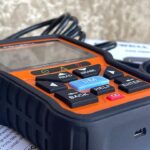The question of whether a 1995 Engine Control Unit (ECU) can be used in a 1996 Volvo 240 to bypass emissions testing by sending false “ready” codes to an OBD scanner has been a topic of debate among car enthusiasts. This article aims to explore the technical aspects of this issue, providing information relevant to those seeking to understand the compatibility of these systems and the potential for such a workaround.
Understanding the OBD System Evolution
To understand this potential ECU swap, it’s crucial to recognize the landscape of On-Board Diagnostics (OBD) systems during the mid-1990s.
- 1995 Volvo 240s and OBD-I: All 1995 Volvo 240 models were equipped with OBD-I systems. However, despite being classified as OBD-I, their ECUs were technically designed to be somewhat forward-compatible, incorporating elements that would later become standard in OBD-II.
- 1995 ECU OBD-II Compliance: According to factory service manual (FSM) schematics, the 1995 ECUs are largely OBD-II compliant from a hardware perspective. This means the wiring harness structure and pin configurations were not radically different from the emerging OBD-II standards.
- OBD-II Port in 1995 Models: Interestingly, 1995 Volvo 240s already featured an OBD-II style port. This port is functional and can be read by Generic Scan Tools (GST), which are early forms of OBD scanners.
- Wiring Consistency: Crucially, the wiring for the OBD-II ports in both 1995 and 1996 models connects to the same pins on their respective ECUs. This physical compatibility is a key point in considering ECU interchangeability.
How Emissions Scanners Work and What They Read
In regions like North Carolina, emissions testing using an OBD scanner focuses on evaluating specific data points from the vehicle’s computer. Based on information from automotive technicians and wiring diagrams, emissions scanners primarily look for:
- Readiness Codes: These codes indicate whether the various emissions control systems have completed their self-tests. A “ready” status signifies that the system has been checked and is functioning, or at least has not reported any failures during the test cycle.
- Fault Codes (Diagnostic Trouble Codes – DTCs): Scanners detect fault codes that have triggered the Malfunction Indicator Lamp (MIL), commonly known as the “check engine light.” These codes point to specific issues within the engine management and emissions systems.
Notably, on older vehicles like the 1996 Volvo 240, the Vehicle Identification Number (VIN) is not typically read by the emissions scanner.
The Core Question: Can a 1995 ECU Fool a Scanner?
The central question is whether a 1995 ECU, known to send an “all clear” signal for OBD-II systems when no faults are present, can effectively bypass the more stringent emissions checks expected of a 1996 model.
- Readiness Code Interpretation: A critical factor is whether emissions scanners are programmed to expect a specific number of readiness codes or simply look for the absence of “Not Ready” codes. If the latter is true, a 1995 ECU might indeed appear compliant by reporting all systems as “ready,” even if it monitors fewer systems than a 1996 ECU.
- Differences in Emissions System Monitoring: The primary difference in emissions wiring between the 1995 and 1996 Volvo 240 models lies in the number of emissions-related systems monitored. The 1996 ECU typically checks approximately three additional systems compared to the 1995 version. These additional checks are generally wired into the MIL fault triggers.
Potential Implications and Further Investigation
While the physical and basic electronic compatibility seems plausible, the effectiveness of using a 1995 ECU to pass a 1996 Volvo 240 in an emissions test remains uncertain.
To definitively answer whether a 1995 ECU can successfully “trick” an emissions scanner, further investigation and potentially practical testing would be required. This could involve:
- Direct Testing: Actually installing a 1995 ECU in a 1996 Volvo 240 and subjecting it to an official emissions test.
- Scanner Protocol Analysis: Detailed analysis of the protocols used by emissions scanners to determine exactly how they interpret readiness codes and fault information.
- Expert Consultation: Seeking input from emissions testing specialists and Volvo technicians with expertise in these specific model years.
Conclusion: Compatibility vs. Compliance
Based on available wiring data and OBD system understanding, there is a degree of technical compatibility between 1995 and 1996 Volvo 240 ECUs regarding basic OBD scanner communication. However, whether this compatibility can be exploited to circumvent emissions testing by using an older ECU to report misleading “ready” status remains an open question. Further research and empirical testing are needed to provide a definitive answer. It is essential to ensure compliance with local emissions regulations, and any modifications should be approached with caution and a thorough understanding of potential legal and environmental consequences.

